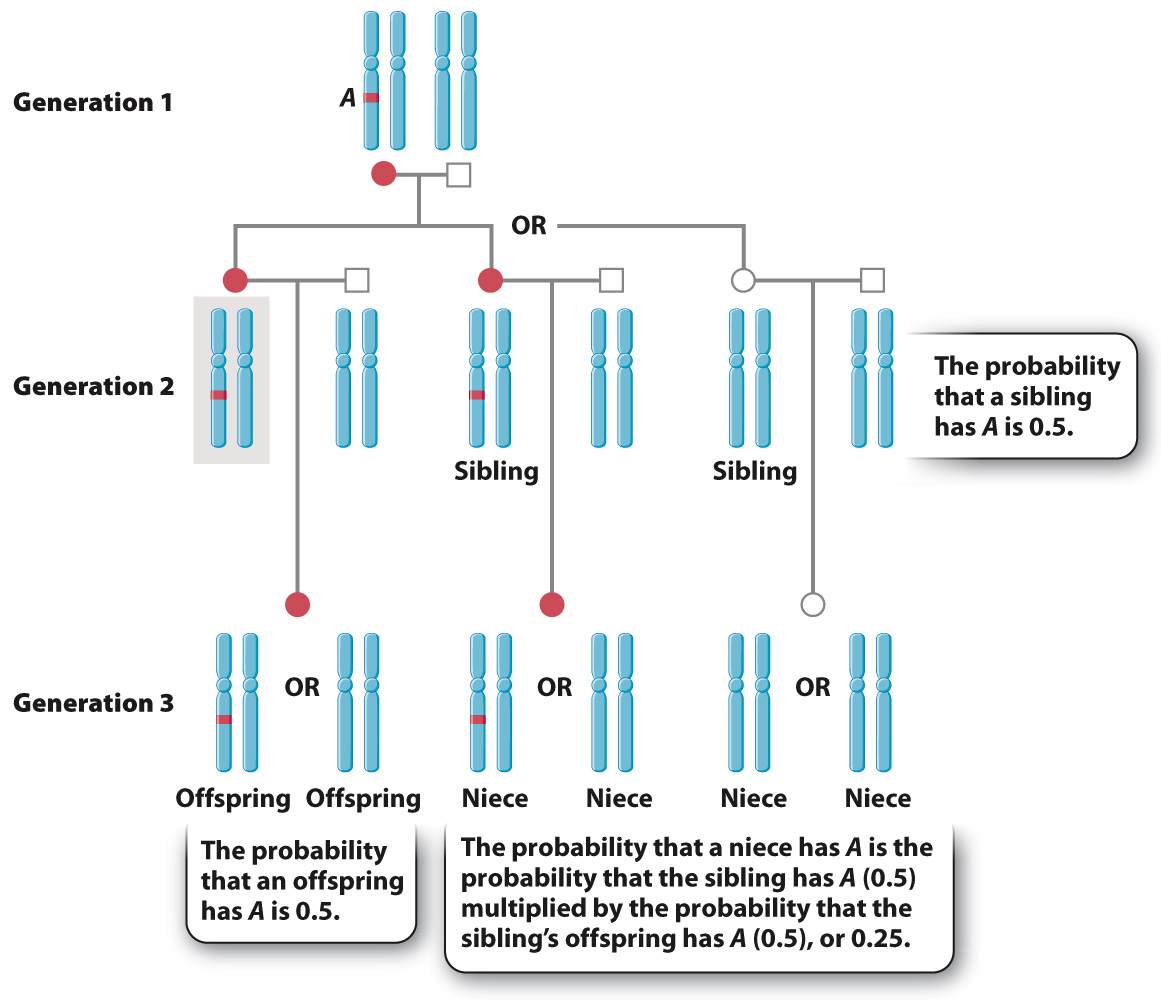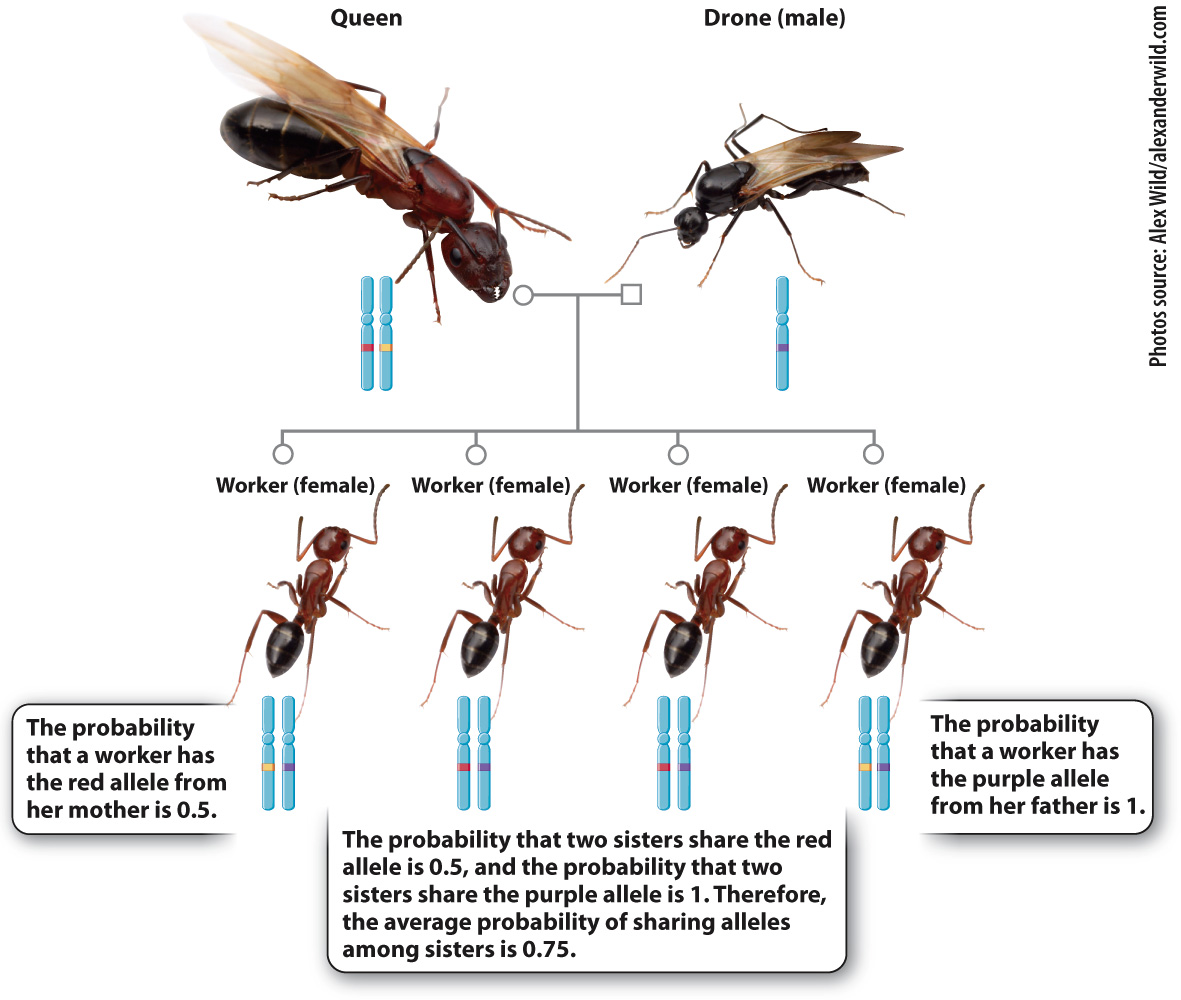The concept of kin selection is based on the idea that it is possible to contribute genetically to future generations by helping close relatives.
In the 1960s, we came to understand that the relatedness of participating individuals has played an important role in the evolution of altruism. This understanding lay in the insight that there are at least two ways to contribute genetically to the next generation: Either an individual can produce its own offspring, or it can produce no offspring and help close relatives reproduce instead. The latter strategy can become established in a population through a process called kin selection, a form of natural selection that favors the spread of alleles that promote behaviors that help close relatives, or kin.
What relationships qualify as kin? Consider the family depicted in Fig. 45.17, with one animal (indicated by gray shading in the figure) that has an allele A at a particular locus. If the animal reproduces, the probability of each offspring inheriting an A allele is 0.5. But what if the animal does not reproduce? According to Mendel’s laws, there is a 50% chance that the animal’s parents passed on the same A allele to the animal’s sibling (Chapter 16). If the sibling does, in fact, inherit allele A, the probability that it passes allele A to each of its offspring is also 0.5. Given the two probabilities (that the sibling has an A, and that the allele passed on to an offspring), the probability that the animal’s niece or nephew has A is 0.25. In other words, a diploid animal (such as humans) is twice as closely related to its own offspring than to its nephew or niece. Therefore, if the animal does not reproduce in order to help its sibling have two offspring, the animal will make the same net genetic contribution to the next generation as it would having one of its own offspring.

Quick Check 5 How many cousins are genetically equivalent to a single offspring?
Quick Check 5 Answer
With reference to Fig. 45.17, the probability of each offspring inheriting an A allele is 0.5. The probability of a cousin sharing an A allele is 0.25, so the probability of each of the animal’s cousin’s offspring having an A is 0.25 × 0.5 = 0.125. In this case, the animal would have to substitute four of its cousin’s offspring for each of its own.
This logic was formalized in 1964 in a famous paper by British evolutionary biologist William D. Hamilton in terms of three key variables: B, the benefit of the behavior to the recipient (how many individuals does the behavior save?); C, the cost of the behavior to the donor (how many offspring are lost?); and r, the degree of relatedness between the recipient and donor. Hamilton asserted that as long as rB exceeds C, altruism can evolve.
How in practice does kin selection work? Let’s start with an extreme case of relatedness: clonal organisms that are genetically identical to each other (meaning that the probability of a sibling’s having allele A is 1). Many aphid species have a phase of their life cycle in which a “mother” aphid reproduces parthenogenetically to produce a small colony of clones of herself (Chapter 42). Any aphid in the colony is capable of reproducing in this way, but in a case of reproductive altruism, some individuals do not reproduce at all. They are “soldier” aphids that defend the colony against predators, typically other insects. As specialized defenders, they do not have the ability to reproduce. In this case, the Hamilton calculation is simple. By helping their clone-
The most famous cases of reproductive altruism occur in the insect group Hymenoptera, which includes ants, bees, and wasps. Many species of Hymenoptera are eusocial, meaning that they have overlapping generations in a nest, cooperative care of the young, and clear and consistent division of labor between reproducers (the queen of a honeybee colony) and nonreproducers (the workers). Often called social insects, these species are one of evolution’s most extraordinary success stories.
What is it about Hymenoptera that predisposed them to eusociality? E. O. Wilson argues that natural selection has strongly favored group behavior in these insects. They typically receive group benefits from living in and defending a nest. For example, they can easily communicate with one another about the location of food resources such as nectar.
William Hamilton also noted that most Hymenoptera have an unusual mode of sex determination: Females (the queen and workers) are diploid, whereas males (drones) are haploid, produced from unfertilized eggs. As a result, the degree of relatedness, r, is higher for the sister–

This form of social organization can result in a huge colony of related individuals all working collectively, much as different cells work collectively within a body. Often, we see specialization into castes: Some ants are soldiers, defending the colony, others are foragers, and so on. If we extend the analogy of individuals acting like cells in a body, the multiple castes are equivalent to organs, all coordinating and working together. The term “superorganism” is sometimes used to describe a single social insect colony.